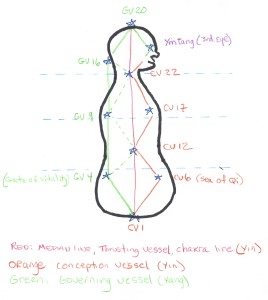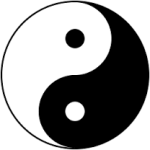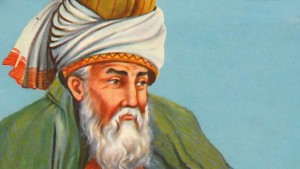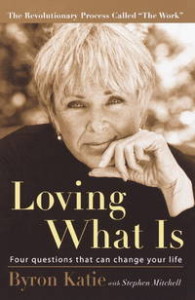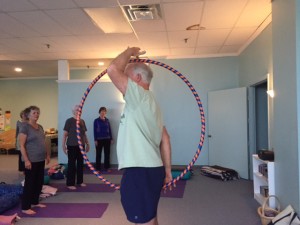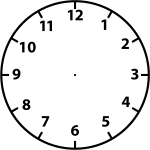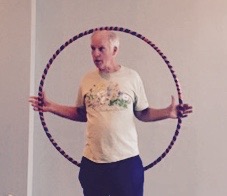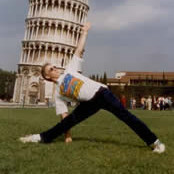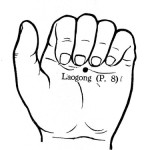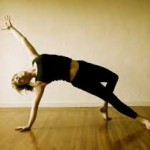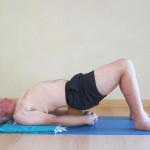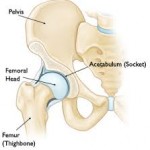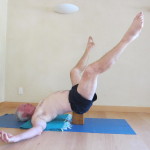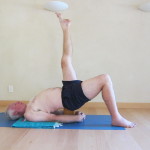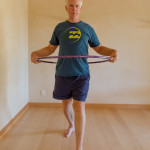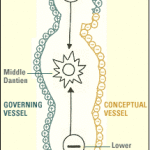Three Treasures: Jing, Qi and Shen
In the previous workshops and posts we’ve been exploring some specific points along the microcosmic orbit and noticing that by bringing our attention to them, and using the breath, we can discover energy lines, planes and volumes, giving us our 3 dimensional sensory/perceptual field of embodiment. In a moment we are going to go more deeply into the volumes, but first we need to add another point to root ourselves more completely. We have been working extensively with CV-1, Hui Yin or the ‘Seat of YIn’, where 4 major yIn vessels meet. (We’ve worked with the Conception and Thrusting vessels. There are two more that link through the legs into the torso.) Our overall imbalance, at all levels, is deficient or repressed yin, which of course represents the feminine, Mother Earth and the inner realms.
In your home practice add GV-1, the first point on the yang Governing Vessel which sits directly in front of the coccyx and directly behind the anus. It is not marked on the diagram above, but CV-1 sits just in front of the anus, making the anal mouth the bridge linking the Conception and Governing Vessels in the lower body. The upper bridge is the upper mouth so we find the gut body a major player in bringing energy balance to the whole.
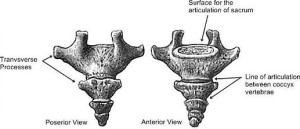 Imagine the connective tissue surrounding the coccyx converging energetically and radiating from this point, GV-1, through the anus to CV-1, CV-6 and all the way to the tailbone of the sternum, the xiphoid process just below CV -17.
Imagine the connective tissue surrounding the coccyx converging energetically and radiating from this point, GV-1, through the anus to CV-1, CV-6 and all the way to the tailbone of the sternum, the xiphoid process just below CV -17.
Now, using your attention and perception, feel energy slowly moving in a small circle, starting at GV-4 ‘down the back and up the front’ to CV-12 and back to GV-4. This will help un-block any yang energy trapped in the lower spinal muscles as it merges with the Yin and stabilize the lower dantien. This is a traditional energetic ‘tucking action’ opening the posterior spine. To ‘untuck, moving the energy in a down the front and up the back circle, do not break the circuit at the anus or the spinal muscles will overwork (excess yang). Rather release and lengthen the ilio-psoas opening the anterior spine. You can also do the full micro-cosmic orbit circle passing through GV-20, the crown chakra point.
When we expand the lower dantien in our breathing and meditation practices, especially rooting down into the earth, this integrating action of the GV-1 point is very important in maintaining the organic integrity and tone. As the volume expands, so does the tone so there is no prolapse of the pelvic organs. If you can find and feel this energy link and strengthen it, your sense of ‘tucking’ will be much more subtle and powerful. No contraction of anything, but there may be subtle adjustments of bones and connective tissue as the body readjusts to the new integration of the base of the body. This action will also help us discover the center channel, aka the ‘Thrusting Vessel’, as this is an expression of balance between front and back, yin and yang, right and left.
The Three Treasures
The alchemy of an embodied spiritual practice, whether yoga, qi gong, is a process of cultivating, integrating and refining the basic substances or energies that make up the embodied human form and living a life based on love, creativity and connection. In Taoist practices, the  basic substances are known collectively as ‘the three treasures‘ and include Jing, Qi and Shen. Each of these treasures is associated with the subtle energy center in one of the three Dantiens, the bony volumes (pelvis, rib cage and skull) and one or more of the yin organ systems. As we can see from the side, our Microcosmic Orbit linking the Conception and Governing Vessels encloses these three dantiens in a loop.
basic substances are known collectively as ‘the three treasures‘ and include Jing, Qi and Shen. Each of these treasures is associated with the subtle energy center in one of the three Dantiens, the bony volumes (pelvis, rib cage and skull) and one or more of the yin organ systems. As we can see from the side, our Microcosmic Orbit linking the Conception and Governing Vessels encloses these three dantiens in a loop.
Dantien translates as ‘elixir field’, implying that there is an alchemical potion stored/hidden in these internal spaces. (A Western perspective would acknowledge each of these spaces has its own ‘nervous system’ as well as hormone secreting glands.) Our embodied spiritual practice awakens, transforms and integrates these three to allow our lives to be radiant expressions of love and creativity, with a large sense of humor to help us deal with the many challenges and limitations of the human condition.
Korean Taoist master Sung Jin Park uses the analogy of a candle to describe the three treasures and Jing, the first is the wax and wick of the candle. The densest of the three, jing is centered in the Lower Dantien and stored in and associated with the Kidney Organ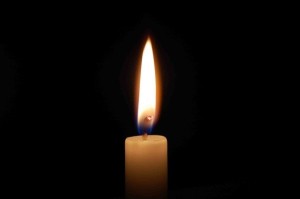 System. There is no good English equivalent, but jing can be seen as the essence of vitality, the seed of life, the creative energy immediately involved with eggs, sperm, DNA and reproduction, the primal source of things. As it has an ancestral connection extending back eons it is often unconscious. Jing provides our constitutional strength and gives us our unique expressions of bones muscles, skin etc.
System. There is no good English equivalent, but jing can be seen as the essence of vitality, the seed of life, the creative energy immediately involved with eggs, sperm, DNA and reproduction, the primal source of things. As it has an ancestral connection extending back eons it is often unconscious. Jing provides our constitutional strength and gives us our unique expressions of bones muscles, skin etc.
Jing differentiates life from inanimate objects, and comes from two sources. Pre-natal Jing comes directly from the DNA of our parents and is nurtured by the kidney energy of our mother while in utero. It determines our basic constitution, is said to be limited in quantity and to be treasured, not wasted. Post-natal Jing is created through the transformation of oxygen and food by the stomach and spleen systems, and the absorbing of life lessons from the environment. It gives birth to the Qi that moves us through life, like the wax gives birth to the flame. Because of its density, it responds strongly to gravity and helps ground us in the larger Cosmos. We can also make a loose analogy with jing to the 1st and 2nd chakras. In our practice, we can help maintain the vitality of our jing through careful diet, hydration, qi moving exercises like yoga and qigong, herbs and acupuncture. Kidney health is crucial to healthy jing, so keep working with K-1, the bubbling spring on the soles of your feet whenever you remember.
The second treasure, Qi, is the flame of the candle, the energy of movement transformed from the denser substance of the body. Qi is the flow of energy from yin to yang and back again, maintaining and allowing both stability and dynamic activity. Qi includes metabolism at a cellular level and all forms of human movement from dance, vinyasa and qigong to rolling around on the floor or walking. Qi’s home in the Middle Dantien and associated with the Spleen/Pancreas and Liver Organ Systems. Chinese Medicine, for help in diagnosis and treatment, describes many types of Qi, but here we are using the word in a general sense for all of its embodied forms.
Like the Sanskrit word Prana, Qi is a Taoist word that cannot be pinned down by Western conceptual thinking. Qi is the mystery of creation itself, neither exactly energy nor matter, but something in between, in an E=mc2 kind of way. Qi is the essence of all levels of reality from sub atomic particles to galaxies. The Qi as a treasure as noted above is a more limited use of the word, but still reflects back onto its more primordial counterpart. We can find a connection to the 3rd and 4th chakras, the solar plexus, heart and lungs. We all feel energy, whether we consciously recognize this or not. Learn to track the quality of your energy and make adjustments as needed. Like with vitalizing the jing, diet, exercise, sleep and an overall healthy life style all support healthy qi.
The candle flame, the Qi, gives off light, and this luminosity is the third treasure, Shen or Spirit. Associated with the heavens and centered in the Upper Dantien, shen is the spiritual mind. The Yin Tang acupuncture point on the 3rd eye is the point (cavity is a better word than point) associated with the Shen as it connects the the very center of the brain where the 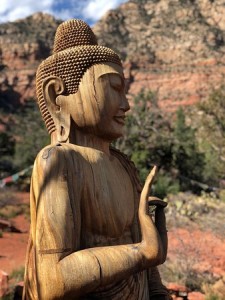 pineal gland resides. Buddha is often depicted with his Pineal (Pine cone like) gland enlarged and protruding, indicating his awakened/enlightened Shen. This lovely Buddha lives in Sedona Arizona and we were just visiting him last month. In esoteric Taoism, this inner space of the brain/skull is called the Spiritual Valley with the ‘Mud Pill Palace at the center which includes the pituitary gland as well. This is the spiritual yin center in the yang upper dantien.
pineal gland resides. Buddha is often depicted with his Pineal (Pine cone like) gland enlarged and protruding, indicating his awakened/enlightened Shen. This lovely Buddha lives in Sedona Arizona and we were just visiting him last month. In esoteric Taoism, this inner space of the brain/skull is called the Spiritual Valley with the ‘Mud Pill Palace at the center which includes the pituitary gland as well. This is the spiritual yin center in the yang upper dantien.
Interestingly enough, although Shen resides in the brain, it is associated with the Heart Organ System which, in Taoist philosophy/science governs the brain. In fact, in Chinese Medicine, the brain is not considered an organ but is known as the ‘sea of marrow’, marrow including bone marrow but also all nerve tissue. Shen can be seen as the radiance of the heart showing directly through the eyes. Cultivation of Shen leads to compassion, loving kindness and a spiritual perspective on all aspects of life. Shen is unbounded by space and time and allows the timeless divine presence to manifest on earth in the human form. When cultivated, by converting Jing to QI and Qi to Shen, it impels the human to live an enlightened life.
The Five Shens
Also similar to Prana, Shen is further subdivided into five different expressions, Shen, Zhi, Yi, Po and Hun. Each of these is connected to one of the five yin organ systems, the five elements of Taoism, the five visible planets and five directions of the compass. As in many Chinese models, the Five Shens are related to society, with the heart Shen as emperor and the other four ministers, so there is a hierarchy here.
The ‘smaller’ Shen is centered in the Heart Organ system and rules the others. As its element is fire, it is spiritual passion in an integrated and compassionate way, inspiring one to live a meaningful life. Its direction is South, the planet Mars. Heart Shen is an embodied expression of the spiritual impulse of joy and delight, and guiding the other aspects of Shen to harmony and balance.
Zhi, or will power gives us direction, discipline and perseverance to gets things done. Connected to the Kidney Organ System and the element water, Zhi, when aligned with the Heart Shen, guides our spiritual practice through the many obstacles that pop up along the way. Its direction is North, the planet mercury, the closest planet to the sun. Zhi can also be seen to have a yin and yang aspect. Yang will is more obvious and usually involves conscious choice in the moment. The Yin aspect of Zhi however is much more mysterious and is not usually noticed until well after the fact, usually later in life when we notice that we were being moved in a direction without actually noticing. At a deeper level of practice, Zhi becomes ‘wu wei’, or effortless effort, as the individual ‘will’ becomes one with the Divine Will of wholeness.
Yi is translated as discriminative intelligence. Associated with the Spleen/Pancreas Organ System, Yi helps distinguish between the desirable and the undesirable choices we have presented to us continuously by our experience. Its element is Earth, its direction is toward the center and its planet is Saturn. Along with Shen/passion and Zhi/will, Yi can be refined by paying careful attention to our actions and the unfolding of the world around us. Yi helps calm the mind when the mental states are disturbed by emotional upheavals.
To make life even more intriguing, the next two “Shens’, Hun and Po, come as a yin/yang pair. Po is the aspect of our being that dissolves at death so, lacking the broader vision of the other four shens, is really only concerned with this physical body, this lifetime. Known in English as the corporeal soul, it is the tangible yin counterpart to Hun, the ethereal soul. Po is associated with the lung organ system, the planet Venus, the element metal and the westerly direction.
Hun represents spirit that lives on after death in other realms of existence. It is the yang counterpart to Po, associated with the Liver Organ System. It carries us in dreams and on shamanic journeys
Discover how these ‘Three Treasures” reveal themselves to you. Nurture and integrate them into your life and learn the alchemy of an embodied spiritual practice.


